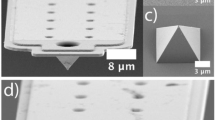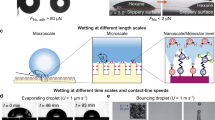Overview
- Authors:
-
-
Byung Il Kim
-
Department of Physics, Boise State University, Boise, USA
Newly developed scanning probe microscopy (SPM) is introduced and principles behind the technique are discussed
Explores the molecular structure of water and how it is manipulatable
Provides readers with substantially different views on nanoscopic water
Access this book
Other ways to access
About this book
Despite advances in the long-range electrostatic double-layer force, which depends strongly on ionic strength in water by using theoretical models such as DLVO (Derjaguin, Landau, Verwey, and Overbeek), the structure of confined water in air still remains widely unknown and has led to a variety of unexplained phenomena. This book bridges that gap by introducing a newly developed scanning probe miscroscopy (SPM) approach, which enables one to probe confined water at the molecular and atomic scale. Written by the developer of SPM, this book covers this new approach, as well as original approaches to addressing general interfacial water issues. It also introduces the cantilever-based optical interfacial force microscope (COIFM), which was invented by the author along with the methodology. The improved understanding will contribute to liquid-based nano- and bio-technologies such as lab-on-a-chip technologies, nanofluidic devices, dip-pen nanolithography, nano-oxidation, water-based granular interactions, liquid-based nanolubricants, hydration layers in biopolymers, manipulation of biomolecules, protein folding, stability of colloid suspensions, enzyme activity, swelling in clays, development of bioactive surfaces, water columns and ion channeling in membranes and scanning probe microscopy (SPM). It will also contribute to the improved performance of moving components in silicon-based micro-electro-mechanical system (MEMS) devices, where water plays a key role in interfacial interactions.
Similar content being viewed by others
Article
Open access
30 December 2019
Article
Open access
28 June 2023
Table of contents (7 chapters)
-
Front Matter
Pages i-xiii
-
-
-
-
-
-
-
-
Back Matter
Pages 155-160
Authors and Affiliations
-
Department of Physics, Boise State University, Boise, USA
Byung Il Kim
About the author
Byung Il Kim, a physics professor at Boise State University, is a leading expert in atomic force microscopy (AFM) where he has worked for more than 30 years. A decade ago he developed a unique technique called COIFM, which led to the discovery of self-assembled water chains. He obtained his Bachelor of Science in Physics at KAIST in Korea. For his Master of Science research project at Seoul National University, he constructed an entire AFM system, the first one to be used in Korea. For his Ph. D research, he applied the home-made AFM system for topographic imaging of high-temperature superconducting thin films, magnetic domain imaging of magnetic thin films, and water-based nano-oxidation patterning on semiconducting surfaces. After his PhD, he came to the United States as a post-doc researcher at the University of Houston. He conducted researches about nanotribology and chiral recognition of organic self-assembly in ultrahigh vacuum environments. Then, he moved to Sandia National Laboratories where he studied fundamental mechanisms for adsorption and desorption of proteins on switchable bio-active surface. Prof. Kim has taught analog and digital electronics and undergraduate/graduate level biophysics for about 20 years. He also enjoys teaching general physics labs for non-physics majors without using complicated physical terminology or calculus. As an effort to share his research work with the general public, he talked to approximately three hundred people about chain-like water at TEDx Boise in 2019. Professor Kim was also a visiting professor at Seoul National University in 2012-2013.




